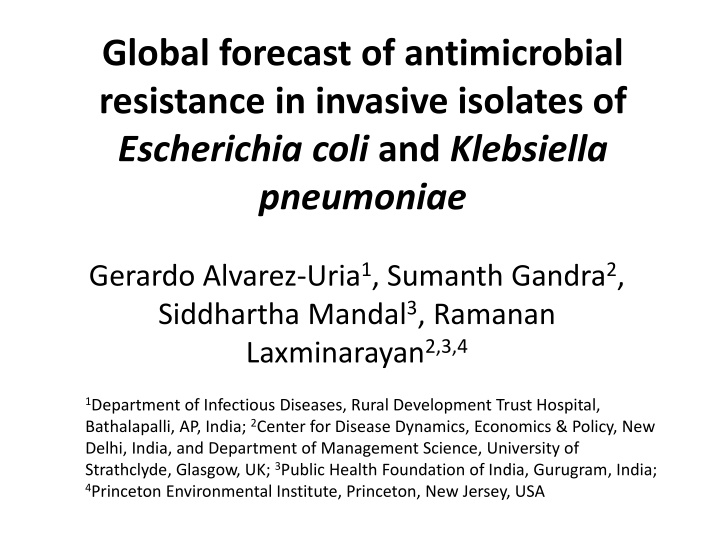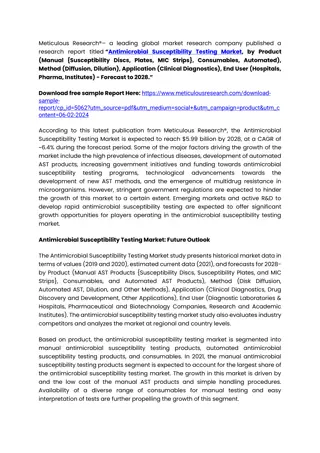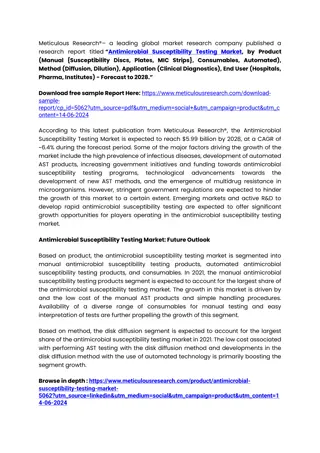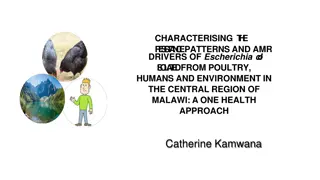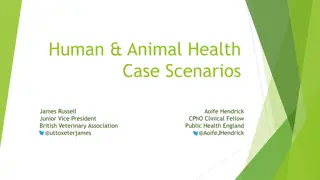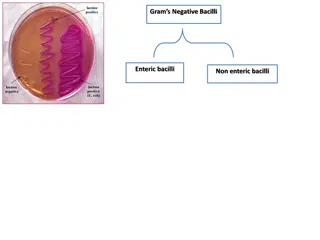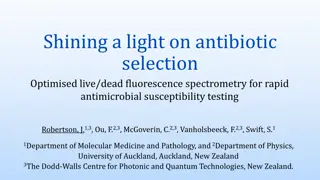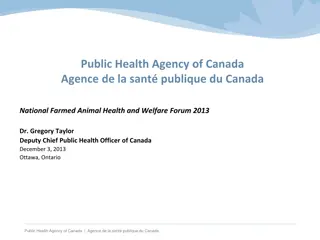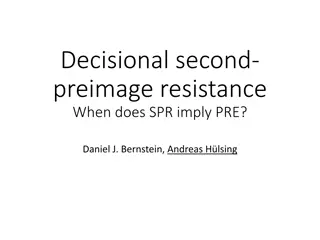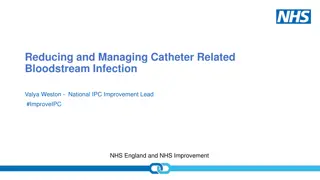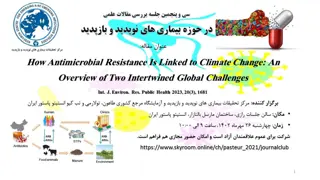Global Forecast of Antimicrobial Resistance in E.coli and K. pneumoniae
This study explores global trends in antimicrobial resistance in Escherichia coli and Klebsiella pneumoniae, projecting future prevalence until 2030. It addresses the critical threat AMR poses to human health, especially in low-resource settings, and examines the impact on mortality rates, hospital stays, and healthcare costs. Utilizing mixed linear modeling, the research draws data from various sources to provide valuable insights and projections regarding the escalating issue of drug-resistant infections caused by these pathogens.
Download Presentation

Please find below an Image/Link to download the presentation.
The content on the website is provided AS IS for your information and personal use only. It may not be sold, licensed, or shared on other websites without obtaining consent from the author.If you encounter any issues during the download, it is possible that the publisher has removed the file from their server.
You are allowed to download the files provided on this website for personal or commercial use, subject to the condition that they are used lawfully. All files are the property of their respective owners.
The content on the website is provided AS IS for your information and personal use only. It may not be sold, licensed, or shared on other websites without obtaining consent from the author.
E N D
Presentation Transcript
Global forecast of antimicrobial resistance in invasive isolates of Escherichia coli and Klebsiella pneumoniae Gerardo Alvarez-Uria1, Sumanth Gandra2, Siddhartha Mandal3, Ramanan Laxminarayan2,3,4 1Department of Infectious Diseases, Rural Development Trust Hospital, Bathalapalli, AP, India; 2Center for Disease Dynamics, Economics & Policy, New Delhi, India, and Department of Management Science, University of Strathclyde, Glasgow, UK; 3Public Health Foundation of India, Gurugram, India; 4Princeton Environmental Institute, Princeton, New Jersey, USA
Journal Club Format Issue being studied Rationale Study design and methodology Results Conclusions Study limitations Study implications Questions/discussion
Issue Being Studied The aims of this study were to estimate global trends in AMR in E. coli and K. pneumoniae and to project future AMR prevalence to 2030.
Rationale Antimicrobial resistance in Enterobacteriaceae is a critical threat to human health Infections caused by third-generation cephalosporin- resistant (3GCR) Enterobacteriaceae are associated with increased mortality rates, length of hospital stay, and healthcare costs . Carbapenems are becoming less reliable as a therapy for 3GCR-resistant Enterobacteriaceae due to rising resistance. Drug-resistant Enterobacteriaceae infections place significant economic burdens on healthcare systems, especially in low-resource settings.
Study Design and Methodology Design: Mixed linear modeling Data sources: o Population data and gross national income per capita obtained from the World Bank o AMR data obtained from CDDEP s ResistanceMap (no data beyond 2015)
Study Design and Methodology AMR data: o 45 countries (31 high-income) reported AMR data for E. coli. o 43 countries (28 high-income) reported AMR data for K. pneumoniae. o No data were reported beyond 2015.
Study Design and Methodology Methods: o Because high-income countries were more likely to monitor AMR, data were adjusted using inverse probability of inclusion weighting. o In a logistic regression model, AMR data was the dependent variable, and per capita income and country population were independent covariates. o Mixed linear modeling to predict AMR trends to 2030 gave weight to data from countries with larger populations.
Results 2015 AMR prevalence: o E. coli 64.5% 3GCR 5.8% carbapenem-resistant o K. pneumoniae 66.9% 3GCR 23.4% carbapenem-resistant
Results Projected AMR prevalence by 2030: o E. coli 77% 3GCR (projected annual variation [PAV]: 0.83%) 11.8% carbapenem-resistant (PAV: 0.4%) o K. pneumoniae 58.2% 3GCR (PAV: -0.58%) 52.8% carbapenem-resistant (PAV: 1.96%)
Conclusions By 2030, more than half of E. coli and K. pneumoniae invasive isolates could be resistant to third-generation cephalosporins. Carbapenem resistance shows signs of rapid increases among K. pneumoniae invasive isolates.
Study Limitations Because the study used a modeling methodology, uncertainty in projections increases with time, and the models didn t account for stabilization factors. Projected annual variations in 3GCR K. pneumoniae were not significantly different from 0, which can be explained by countries with an initially low prevalence showing a rising trend, while countries with an initially high prevalence (eg, India, South Africa) may experience stabilizing or decreasing rates.
Study Limitations The model couldn t distinguish between community-associated and hospital-acquired infections, the latter of which would be associated with higher AMR rates. Though models were adjusted for the low amount of AMR data from low-income countries, actual surveillance data from these settings are needed in order to make accurate global projections.
Study Implications By 2030, countries may face a shortage of effective antimicrobials that treat cases of sepsis, abdominal infections, and urinary tract infections caused by Enterobacteriaceae. Empirical treatment of invasive E. coli and K. pneumoniae infections will need to cover high 3GCR rates, which may lead to an increase in carbapenem use. Isolated interventions to reduce AMR in Enterobacteriaceae in high-income countries will only have a partial effect without addressing resource shortages and environmental factors in low- and middle-income settings.
